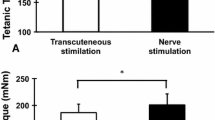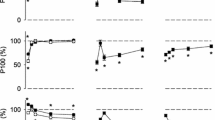Abstract
Effects of fibre type composition and type of contraction on low-frequency fatigue (LFF) were investigated in isolated rat medial gastrocnemius (GM) muscle. Fast oxidative or fast glycolytic GM muscle parts of anaesthetised male Wistar rats (n=18) were activated selectively by maximal electrical stimulation of the nerve after selective cutting of sub-branches. LFF was induced by a series of 40 isometric, concentric or eccentric contractions. Post exercise (55 min), the force–frequency curves differed significantly from the pre-exercise curves. Decreased forces were exerted mainly at the lower frequencies. This effect was significantly greater for glycolytic than oxidative muscle parts and following eccentric compared to isometric and concentric exercise. Seventy minutes following eccentric exercise, the relative values of the 60:200 Hz force ratios for the oxidative compared to the glycolytic parts were 65.6±2.2% and 43.6±4.6% (mean±SE) of the pre-fatigue values (=100%), respectively. In conclusion, for conditions of identical activation, eccentric exercise led to significantly more LFF than isometric and concentric exercise. In addition, and independent of the exercise type, fast glycolytic muscle parts were more susceptible to LFF than fast oxidative muscle parts.




Similar content being viewed by others
References
Armstrong RB (1984) Mechanisms of exercise-induced delayed onset muscular soreness: a brief review. Med Sci Sports Exerc 16:529–538
Armstrong RB, Ogilvie RW, Schwane JA (1983) Eccentric exercise-induced injury to rat skeletal muscle. J Appl Physiol 54:80–93
Byström S, Kilbom A (1991) Electrical stimulation of human forearm extensor muscles as an indicator of handgrip fatigue and recovery. Eur J Appl Physiol 62:363–368
De Haan A (1990) High-energy phosphates and fatigue during repeated dynamic contractions of rat muscle. Exp Physiol 75:851–854
De Haan A, Jones DA, Sargeant AJ (1989) Changes in velocity of shortening, power output and relaxation rate during fatigue of rat medial gastrocnemius muscle. Pflugers Arch 413:422–428
De Haan A, Lodder MAN, Sargeant AJ (1989) Age-related effects of fatigue and recovery from fatigue in rat medial gastrocnemius muscle. Q J Exp Physiol 74:715–726
De Ruiter CJ, De Haan A, Sargeant AJ (1995) Physiological characteristics of two extreme muscle compartments in gastrocnemius medialis of the anaesthetized rat. Acta Physiol Scand 153:313–324
Dudley GA, Harris RT, Duvoisin MR, Hather BM, Buchanan P (1990) Effect of voluntary vs. artificial activation on the relationship of muscle torque to speed. J Appl Physiol 69:2215–2221
Edwards RH, Hill DK, Jones DA (1975) Metabolic changes associated with the slowing of relaxation in fatigued mouse muscle. J Physiol (Lond) 251:287–301
Edwards RHT, Hill DK, Jones DA, Merton PA (1977) Fatigue of long duration in human skeletal muscle after exercise. J Physiol (Lond) 272:769–778
Edwards RHT, Mills KR, Newham DJ (1981) Greater low frequency fatigue produced by eccentric than concentric muscle contractions. J Physiol (Lond) 317:17P
Evans WJ, Meredith CN, Cannon JG et al (1986) Metabolic changes following eccentric exercise in trained and untrained men. J Appl Physiol 61:1864–1868
Hennig R, Lømo T (1987) Gradation of force output in normal fast and slow muscles of the rat. Acta Physiol Scand 130:133–142
Heslinga JW, Hui**g PA (1990) Effects of growth on architecture and functional characteristics of adult rat gastrocnemius muscle. J Morphol 206:119–132
Hesselink MK, Kuipers H, Geurten P, Van Straaten H (1996) Structural muscle damage and muscle strength after incremental number of isometric and forced lengthening contractions. J Muscle Res Cell Motil 17:335–341
Hill CA, Thompson MW, Ruell PA, Thom JM, White MJ (2001) Sarcoplasmic reticulum function and muscle contractile character following fatiguing exercise in humans. J Physiol (Lond) 531:871–878
Hui**g PA, Baan GC (2001) Extramuscular myofascial force transmission within the rat anterior tibial compartment: proximo-distal differences in muscle force. Acta Physiol Scand 173:297–311
Jami L, Murthy KS, Petit J, Zytnicki D (1983) After-effects of repetitive stimulation at low frequency on fast-contracting motor units of cat muscle. J Physiol (Lond) 340:129–143
Jones DA (1981) Muscle fatigue due to changes beyond the neuromuscular junction. Ciba Found Symp 82:178–196
Jones DA (1996) High-and low-frequency fatigue revisited. Acta Physiol Scand 156:265–270
Jones DA, Howell S, Roussos C, Edwards RH (1982) Low-frequency fatigue in isolated skeletal muscles and the effects of methylxanthines. Clin Sci (Lond) 63:161–167
Lieber RL, Friden J (1988) Selective damage of fast glycolytic muscle fibres with eccentric contraction of the rabbit tibialis anterior. Acta Physiol Scand 133:587–588
Lieber RL, Friden J (1993) Muscle damage is not a function of muscle force but active muscle strain. J Appl Physiol 74:520–526
Linnamo V, Moritani T, Nicol C, Komi PV (2003) Motor unit activation patterns during isometric, concentric and eccentric actions at different force levels. J Electromyogr Kinesiol 13:93–101
Maas H, Baan GC, Hui**g PA (2001) Intermuscular interaction via myofascial force transmission: effects of tibialis anterior and extensor hallucis longus length on force transmission from rat extensor digitorum longus muscle. J Biomech 34:927–940
Newham DJ, Mills KR, Quigley BM, Edwards RH (1983) Pain and fatigue after concentric and eccentric muscle contractions. Clin Sci 64:55–62
Pasquet B, Carpentier A, Duchateau J, Hainaut K (2000) Muscle fatigue during concentric and eccentric contractions. Muscle Nerve 23:1727–1735
Patel TJ, Cuizon D, Mathieu-Costello O, Friden J, Lieber RL (1998) Increased oxidative capacity does not protect skeletal muscle fibers from eccentric contraction-induced injury. Am J Physiol 274: R1300–R1308
Powers RK, Binder MD (1991) Effects of low-frequency stimulation on the tension-frequency relations of fast-twitch motor units in the cat. J Neurophysiol 66:905–918
Proske U, Morgan DL (2001) Muscle damage from eccentric exercise: mechanism, mechanical signs, adaptation and clinical applications. J Physiol (Lond) 537:333–345
Ratkevicius A, Skurvydas A, Povilonis E, Quistorff B, Lexell J (1998) Effects of contraction duration on low-frequency fatigue in voluntary and electrically induced exercise of quadriceps muscle in humans. Eur J Appl Physiol 77:462–468
Roszek B, Baan GC, Hui**g PA (1994) Decreasing stimulation frequency-dependent length-force characteristics of rat muscle. J Appl Physiol 77:2115–2124
Skurvydas A, Dudoniene V, Kalvenas A, Zuoza A (2002) Skeletal muscle fatigue in long-distance runners, sprinters and untrained men after repeated drop jumps performed at maximal intensity. Scand J Med Sci Sports 12:34–39
Stephenson DG, Lamb GD, Stephenson GM (1998) Events of the excitation-contraction-relaxation (E-C-R) cycle in fast- and slow-twitch mammalian muscle fibres relevant to muscle fatigue. Acta Physiol Scand 162:229–245
Takekura H, Fu**ami N, Nishizawa T, Ogasawara H, Kasuga N (2001) Eccentric exercise-induced morphological changes in the membrane systems involved in excitation-contraction coupling in rat skeletal muscle. J Physiol (Lond) 533:571–583
Webber S, Kriellaars D (1997) Neuromuscular factors contributing to in vivo eccentric moment generation. J Appl Physiol 83:40–45
Westerblad H, Duty S, Allen DG (1993) Intracellular calcium concentration during low-frequency fatigue in isolated single fibers of mouse skeletal muscle. J Appl Physiol 75:382–388
Westing SH, Seger JY, Karlson E, Ekblom B (1988) Eccentric and concentric torque-velocity characteristics of the quadriceps femoris in man. Eur J Appl Physiol 58:100–104
Wood SA, Morgan DL, Proske U (1993) Effects of repeated eccentric contractions on structure and mechanical properties of toad sartorius muscle. Am J Physiol 265:C792–C800
Zuurbier CJ, Hui**g PA (1993) Changes in geometry of actively shortening unipennate rat gastrocnemius muscle. J Morphol 218:167–180
Author information
Authors and Affiliations
Corresponding author
Rights and permissions
About this article
Cite this article
Rijkelijkhuizen, J.M., de Ruiter, C.J., Hui**g, P.A. et al. Low-frequency fatigue is fibre type related and most pronounced after eccentric activity in rat medial gastrocnemius muscle. Pflugers Arch - Eur J Physiol 447, 239–246 (2003). https://doi.org/10.1007/s00424-003-1172-2
Received:
Revised:
Accepted:
Published:
Issue Date:
DOI: https://doi.org/10.1007/s00424-003-1172-2




